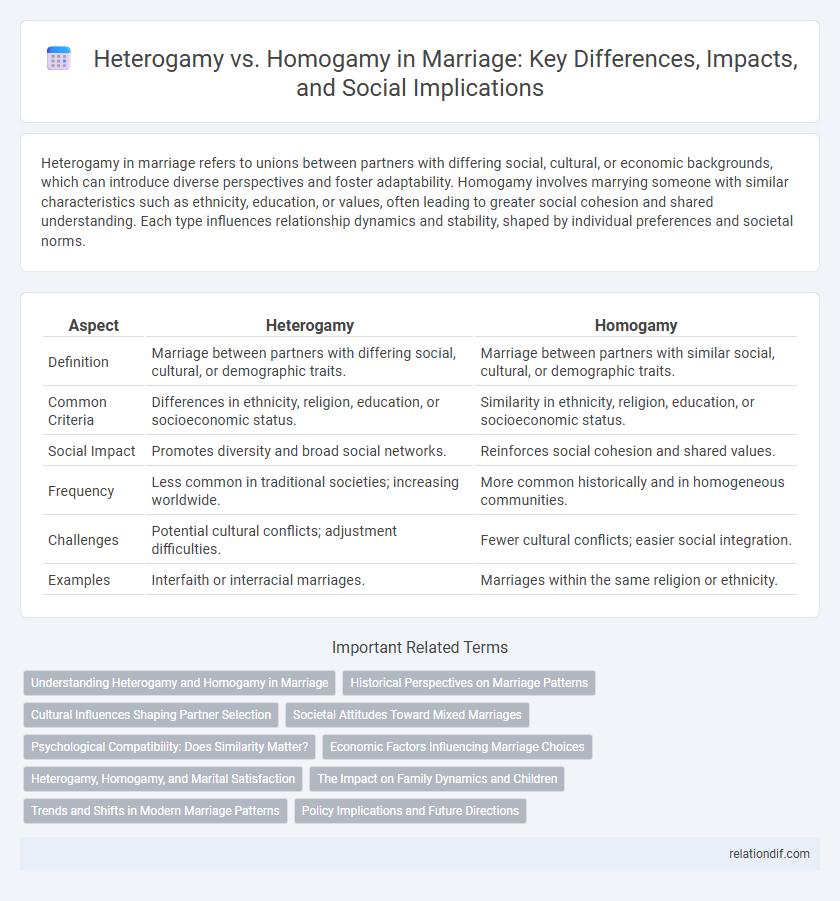Heterogamy in marriage refers to unions between partners with differing social, cultural, or economic backgrounds, which can introduce diverse perspectives and foster adaptability. Homogamy involves marrying someone with similar characteristics such as ethnicity, education, or values, often leading to greater social cohesion and shared understanding. Each type influences relationship dynamics and stability, shaped by individual preferences and societal norms.
Table of Comparison
| Aspect | Heterogamy | Homogamy |
|---|---|---|
| Definition | Marriage between partners with differing social, cultural, or demographic traits. | Marriage between partners with similar social, cultural, or demographic traits. |
| Common Criteria | Differences in ethnicity, religion, education, or socioeconomic status. | Similarity in ethnicity, religion, education, or socioeconomic status. |
| Social Impact | Promotes diversity and broad social networks. | Reinforces social cohesion and shared values. |
| Frequency | Less common in traditional societies; increasing worldwide. | More common historically and in homogeneous communities. |
| Challenges | Potential cultural conflicts; adjustment difficulties. | Fewer cultural conflicts; easier social integration. |
| Examples | Interfaith or interracial marriages. | Marriages within the same religion or ethnicity. |
Understanding Heterogamy and Homogamy in Marriage
Heterogamy in marriage refers to unions between partners with different social, cultural, or demographic backgrounds, such as age, ethnicity, or education level, highlighting diversity in relationships. Homogamy emphasizes marriages where partners share similar characteristics, promoting social compatibility and shared values that can lead to greater marital stability. Understanding the dynamics of heterogamy and homogamy helps in analyzing marriage patterns, relationship satisfaction, and social integration within diverse communities.
Historical Perspectives on Marriage Patterns
Historical perspectives on marriage patterns reveal that homogamy, the practice of marrying within similar social, cultural, or ethnic groups, was predominant in many traditional societies to preserve social cohesion and economic stability. In contrast, heterogamy, or marrying across differing social, cultural, or ethnic lines, gained prominence with urbanization and modernization, reflecting increased social mobility and changing cultural norms. Studies of historical demographic data highlight how economic factors, religious norms, and legal restrictions have influenced the prevalence of homogamous versus heterogamous unions over time.
Cultural Influences Shaping Partner Selection
Cultural influences significantly shape partner selection by promoting either heterogamy or homogamy based on social norms and values within a community. Homogamy often reflects shared ethnicity, religion, or socioeconomic status, reinforcing cultural continuity and social cohesion. In contrast, heterogamy may occur in more diverse or globalized societies where cultural boundaries are less rigid, encouraging partnerships across different cultural backgrounds.
Societal Attitudes Toward Mixed Marriages
Societal attitudes toward mixed marriages, encompassing both heterogamous (differing backgrounds) and homogamous (similar backgrounds) unions, vary significantly across cultures and historical periods. Research indicates that heterogamy often faces social resistance due to prevailing norms about race, religion, or socioeconomic status, which can impact social acceptance and policy support. In contrast, homogamous marriages tend to align more closely with societal expectations, resulting in higher approval rates and fewer social obstacles.
Psychological Compatibility: Does Similarity Matter?
Psychological compatibility in marriage often hinges on homogamy, where couples share similar values, beliefs, and personality traits, fostering mutual understanding and emotional connection. Heterogamous marriages, involving partners with differing psychological profiles, may face challenges in communication and conflict resolution but can also benefit from complementary traits that encourage growth and adaptability. Research indicates that while similarity enhances relationship satisfaction, successful partnerships rely equally on effective communication and emotional support.
Economic Factors Influencing Marriage Choices
Economic factors significantly influence marriage choices, with homogamy often favored due to aligned financial stability and shared socioeconomic status. Couples with similar income levels and educational backgrounds tend to experience less financial stress and greater economic cooperation. In contrast, heterogamy, involving partners from different economic classes, may face challenges related to income disparity and divergent financial priorities.
Heterogamy, Homogamy, and Marital Satisfaction
Heterogamy, the marriage between individuals from different social, cultural, or demographic backgrounds, contrasts with homogamy, where partners share similar characteristics such as age, education, and ethnicity. Studies indicate that homogamous couples often report higher marital satisfaction due to shared values and communication styles, while heterogamous marriages may face challenges but also benefit from diverse perspectives. Marital satisfaction in heterogamous relationships depends on mutual respect, adaptability, and effective conflict resolution, emphasizing the importance of understanding differences for a successful partnership.
The Impact on Family Dynamics and Children
Heterogamy, involving unions between partners with differing social, cultural, or economic backgrounds, often introduces diverse perspectives that can enrich family dynamics but may also lead to conflicts due to contrasting values. Homogamy, where partners share similar backgrounds, tends to create more cohesive family environments with consistent parenting approaches and cultural practices. Research indicates children in homogamous families often experience greater stability and shared identity, while those in heterogamous families benefit from broader social exposure and adaptability.
Trends and Shifts in Modern Marriage Patterns
Modern marriage patterns reveal a significant shift towards homogamy, with a growing number of couples sharing similar educational backgrounds, socioeconomic status, and cultural values. However, heterogamy remains prevalent in diverse urban areas, driven by increased social mobility and multicultural interaction. These trends reflect broader societal changes emphasizing both shared identity for stability and diversity for adaptability in contemporary unions.
Policy Implications and Future Directions
Policies addressing heterogamy and homogamy in marriage must consider social integration, inequality reduction, and cultural cohesion to foster inclusive communities and equitable opportunities. Research on assortative mating patterns guides reforms in housing, education, and anti-discrimination laws aiming to balance diversity with social stability. Future directions emphasize data-driven strategies promoting mutual respect across diverse socio-economic and ethnic backgrounds to enhance marital satisfaction and societal harmony.
Heterogamy vs Homogamy Infographic

 relationdif.com
relationdif.com